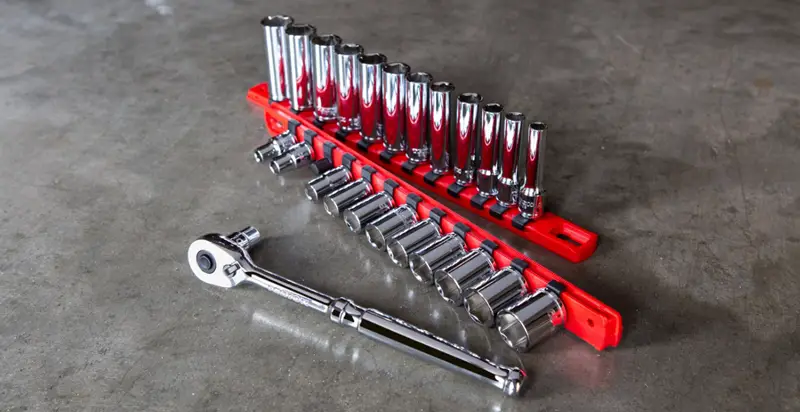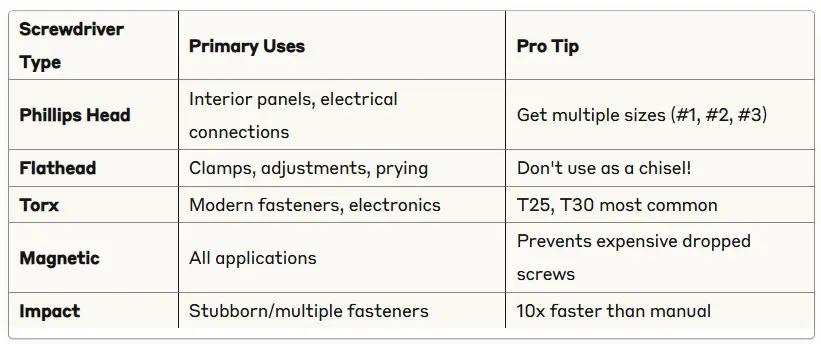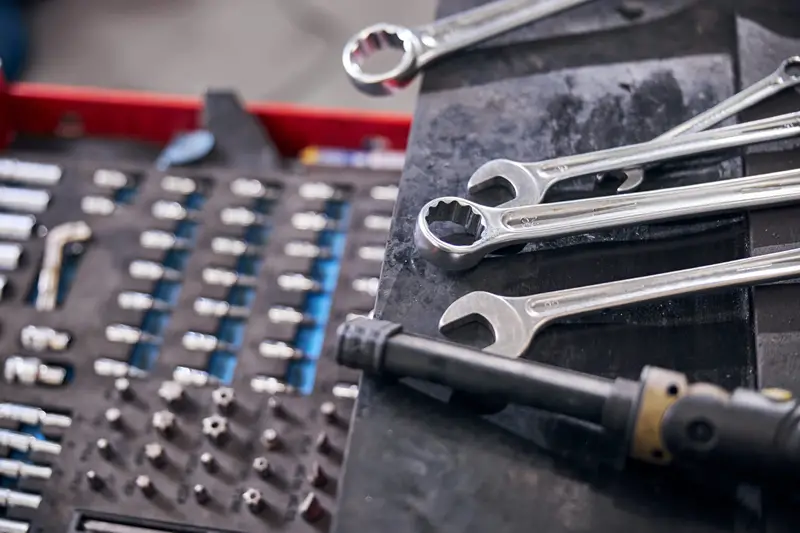Ever found yourself stranded on the side of the road, wallet lighter after yet another expensive mechanic visit? Trust me, I’ve been there. But what if I told you that with the right diy car repair tools, you could handle most basic maintenance and repairs yourself?
You’re probably thinking, “But I’m not a mechanic!” Here’s the thing – you don’t need to be. Modern cars might seem complicated, but with the right automotive repair tools and a little know-how, you can tackle everything from oil changes to brake pad replacements. Ready to transform your garage into a money-saving workshop?
Also read: Check Engine Light Diagnosis: Essential 6-Step Guide
Key Takeaways: Your DIY Car Repair Tools Success Roadmap
✅ Start with essential basics – A quality socket set, combination wrenches, and safety equipment form your foundation
✅ Invest in safety first – Jack stands, safety glasses, and proper protective equipment are non-negotiable
✅ Buy mid-range quality – You don’t need professional-grade everything, but avoid the cheapest options for critical tools
✅ OBD-II scanners save hundreds – Modern diagnostic tools pay for themselves after just one use
✅ Proper storage prevents chaos – Organized tools mean efficient repairs and less frustration
✅ Power tools boost efficiency – Battery-powered impact tools turn hours-long jobs into 30-minute tasks
also remember:
✅ Oil changes are your gateway – Master this simple task to build confidence for bigger repairs
✅ Torque wrenches prevent disasters – Proper fastener tension protects your engine and ensures safety
✅ Build gradually, not all at once – Add specialized tools as you take on more complex projects
✅ ROI happens fast – Most tool investments pay for themselves within 3-6 months of regular use
✅ Knowledge multiplies value – Each repair teaches skills that make future projects easier and faster
✅ Mobile mechanics provide backup – Professional help is always available when jobs exceed your skill level
Table of Contents
Why Every Car Owner Needs Basic DIY Car Repair Tools
Let’s face it – diy car repair tools aren’t just for professionals anymore. Having the right tools to perform basic DIY auto repairs and maintenance can save you time and money. But it’s more than just savings; it’s about independence and understanding your vehicle.
Think about it: when was the last time you paid $150 for an oil change that takes 20 minutes? Or $300 for brake pads that cost $40 at the auto parts store? That’s where having your own mechanic tools pays off literally.
Here’s what blew my mind when I first started: the average car owner spends $1,200 annually on maintenance and repairs. With a good set of automotive tools, you could cut that in half. Not convinced yet? Keep reading.

Socket Sets: Your Foundation for Your DIY Car Repair Tools Collection
Every diy car repair tools collection starts with a quality socket set. Why? Because practically every bolt on your car requires one. You’ll need both metric and standard sizes, but don’t panic – most modern vehicles use metric.
A good socket set should include 1/4″, 3/8″, and 1/2″ drive sizes. The 3/8″ drive is your workhorse for most car repair equipment tasks. Look for sets with both shallow and deep sockets – trust me, you’ll need both when working in tight spaces.
What makes a socket set worth buying? Chrome vanadium steel construction, comfortable grip ratchets, and a sturdy case. SK offers mechanic tool sets, sockets, ratchets, wrenches, screwdrivers, tool storage, and more… SK is a great choice for those looking for quality tools at an affordable price point.
Chart 1: Socket Set Investment vs. Savings

Wrenches and Spanners: The Backbone of DIY Car Repair Tools
Here’s where things get interesting with professional automotive tools. Combination wrenches (box end on one side, open end on the other) are absolute game-changers. You’ll reach for these more than you’d expect, especially for suspension work and engine repairs.
Don’t underestimate adjustable wrenches. I know, I know—“real mechanics” supposedly avoid them. But when you’re lying under your car at 9 PM trying to reach that one stubborn bolt, you’ll be glad that adjustable wrench is in your stash of diy car repair tools.
Pro tip: invest in a quality torque wrench. It’s one of the most important diy car repair tools you can own. It’s not just about getting bolts tight—it’s about getting them right. Over-tighten a head bolt and you risk ruining your engine. Under-tighten a wheel lug? Let’s not even imagine the consequences.
Screwdrivers: More Than Just Basic Hand Tools for Cars
Think screwdrivers are boring? Think again! Modern auto repair tools include specialized screwdrivers that’ll make your life so much easier. You need Phillips, flathead, and Torx drivers at minimum.
But here’s what most people miss: get magnetic tips. Seriously, when you’re working upside-down under a hood, dropped screws become expensive problems. Magnetic screwdrivers are like having a third hand.
Impact drivers deserve special mention too. Battery-powered impact drivers have revolutionized home car repair tools. They’ll power through stuck screws that would strip with manual drivers. Just remember – impact drivers are for screws, not bolts (that’s what impact wrenches are for).
Chart 2: Essential Screwdriver Types and Uses

Pliers: The Unsung Heroes of Automotive Tool Sets
Every diy car mechanic tools collection needs quality pliers. We’re talking needle-nose, standard, and locking pliers (Vice-Grips). But don’t stop there – wire strippers and diagonal cutters are essential for electrical work.
Locking pliers deserve special praise. These bad boys can grab, hold, twist, and pull like nothing else. Stripped bolt head? Locking pliers. Stubborn hose clamp? Locking pliers. Stuck brake caliper piston? You guessed it.
One type most people overlook: snap ring pliers. If you ever work on CV joints, transmissions, or suspension components, you’ll curse the day you tried to remove snap rings with regular pliers. Trust me on this one.
Jack and Jack Stands: Essential Car Lifting Equipment
Here’s where safety meets necessity in your car maintenance equipment. One of the most important tools for completing DIY automotive tasks is a vehicle jack. Without this tool, it’s incredibly difficult to access several key components of the vehicle, including the oil filter, transmission fluid pan, and brakes.
But here’s the critical part – NEVER trust just a jack. Jack stands save lives, period. I don’t care if you’re just changing oil; use jack stands. That hydraulic jack can fail, and 3,000 pounds of car doesn’t care about your good intentions.
Floor jacks are worth the investment over scissor jacks. They’re faster, more stable, and work from the side rather than requiring you to crawl under a partially lifted car. Look for at least 2-ton capacity for most cars, 3-ton for SUVs and trucks.
Diagnostic Tools: Modern Car Troubleshooting Equipment
Modern automotive diagnostic tools have gotten incredibly sophisticated – and affordable. An OBD-II scanner is no longer optional; it’s essential. These plug into your car’s diagnostic port and read error codes that used to require expensive dealer visits.
But don’t stop at basic code readers. Advanced scanners can show live data, reset service lights, and even perform basic programming functions. Some connect to your smartphone via Bluetooth, making diagnostics as easy as checking your email.
Multimeters round out your diagnostic arsenal. Electrical problems can be tricky, but a good multimeter takes the guesswork out of voltage, continuity, and resistance testing. You’ll use it more than you think – everything from checking battery voltage to testing sensors.
Chart 3: Diagnostic Tool ROI Comparison

Power Tools: Boosting Your DIY Car Repair Efficiency
Battery-powered tools have revolutionized diy auto repair tools. Impact wrenches, drills, and grinders can turn hours-long jobs into 30-minute tasks. But here’s the key – stick with one battery system. Milwaukee, DeWalt, Makita – pick one and stick with it.
Impact wrenches deserve special mention. Lug nuts that would take forever with a breaker bar? Gone in seconds. Suspension bolts that laugh at regular ratchets? Not a problem. Just remember to hand-tighten critical fasteners to proper torque specs afterward.
Angle grinders are fantastic for cutting rusted bolts, cleaning metal, and removing stubborn components. Just respect the power – these tools can cause serious injury if misused. Always wear safety glasses and gloves.
Oil Change Tools: Your Gateway to Automotive Independence
Oil changes are the perfect introduction to car repair tools. You’ll need an oil drain pan, oil filter wrench, funnel, and the right socket for your drain plug. Seems simple, but there are tricks to make it easier.
Magnetic drain pans are brilliant additions to your set of diy car repair tools—they catch metal shavings that could signal engine wear. Fumoto valves replace traditional drain plugs with easy-to-use levers, making oil changes cleaner and faster. Oil extractors are another smart option, allowing you to remove oil through the dipstick tube without crawling under the car.
And don’t forget one of the most overlooked steps in using diy car repair tools: proper disposal. Used oil and filters must be recycled. Thankfully, most auto parts stores accept them for free. It’s not just the right thing to do for the environment—it’s often legally required.
Brake Service Tools: Safety-Critical Equipment
Brake work requires specialized automotive repair equipment. C-clamps or brake piston tools compress pistons when installing new pads. Brake bleeder kits ensure proper brake fluid changes. These aren’t optional – they’re safety critical.
Here’s what terrifies me: people compressing brake pistons with regular pliers or pushing fluid back into the master cylinder. Don’t do this! Old brake fluid often contains moisture and debris that can damage sensitive ABS components. When using your diy car repair tools for brake jobs, always follow proper bleeding procedures to avoid costly repairs.
Brake line wrenches (flare nut wrenches) are essential diy car repair tools when working on brake line connections. Regular wrenches can round off those soft fittings, leading to expensive headaches. A quality set is a smart investment—your brake lines (and your sanity) will thank you.
Storage Solutions: Organizing Your Automotive Tool Collection
Great mechanic tool sets need great storage. Toolboxes keep everything organized and protected. But here’s what matters: accessibility. If you can’t quickly find the right tool, you’ll lose motivation fast.
Rolling tool chests are ideal for garages with smooth floors, keeping your diy car repair tools mobile and accessible. For jobs on the go, portable tool bags are a smart pick—they make it easy to bring the essentials right to the car. Wall-mounted storage helps save floor space while keeping your most-used tools within easy reach.
Drawer organizers and magnetic strips help prevent the dreaded “tool soup” problem. You know the one—where sockets, wrenches, and random bits of metal all tangle together in one chaotic drawer. Keeping your diy car repair tools organized isn’t just about looks; it boosts your efficiency and helps you get the job done faster.
Chart 4: Tool Storage Investment Guide

Budget-Friendly vs Professional Grade Tool Options
Here’s the truth about affordable car repair tools: you don’t need to break the bank starting out. But you also don’t want tools that break on first use. The sweet spot? Mid-range tools from reputable manufacturers.
Harbor Freight often gets a bad rap, but their Pittsburgh Pro line actually offers decent quality for diy car repair tools at home. Brands like Kobalt (Lowe’s) and Husky (Home Depot) also provide solid warranties and reliable performance. For sockets and wrenches, these budget-friendly options work well for most homeowners doing regular maintenance.
So, when should you splurge on professional-grade diy car repair tools? Focus on tools you’ll use often or those tied directly to safety—like torque wrenches, jack stands, and brake tools. These are worth the extra investment for peace of mind and durability. For everything else, mid-range tools are a smart starting point. You can always upgrade as your skills and needs grow.
15 Must-Have Tools Every DIY Mechanic Needs
Ready for the complete list? Here are the essential DIY car repair tools that’ll handle 80% of your maintenance needs:
- Socket Set (3/8″ drive) – Your foundation tool
- Combination Wrench Set – For tight spaces
- Screwdriver Set – Phillips, flathead, and Torx
- Pliers Set – Needle-nose, standard, and locking
- Floor Jack – Safe, efficient lifting
- Jack Stands – Critical safety equipment
- OBD-II Scanner – Modern diagnostics
- Multimeter – Electrical troubleshooting
- Oil Drain Pan – Clean oil changes
- Oil Filter Wrench – Remove stubborn filters
- Torque Wrench – Proper fastener tension
- Funnel Set – Clean fluid transfers
- Work Light – See what you’re doing
- Safety Glasses – Protect your eyes
- Disposable Gloves – Keep hands clean
This list covers everything from basic maintenance to intermediate repairs. Start here, then add specialized tools as your skills grow.
Common DIY Car Repair Tool Myths Debunked
Myth #1: “You need expensive tools to do quality work”
Wrong! You don’t need high-end gear to get the job done. Mid-range diy car repair tools handle most tasks perfectly. Save the premium-grade stuff for frequently used items or safety-critical applications where quality matters most.
Myth #2: “Harbor Freight tools are all junk”
Not anymore. Their Pittsburgh Pro line offers surprisingly decent quality for diy car repair tools at home. Just steer clear of their absolute cheapest tools, especially when working on brakes, suspension, or other critical systems.
Myth #3: “Impact tools will over-tighten everything”
Only if you misuse them. Impact tools are great for removing bolts or quick installs, but always finish the job using a torque wrench and proper specs. When used correctly, these diy car repair tools are a time-saver—not a liability.
Myth #4: “You need every tool before starting”
Absolutely not! Build your kit gradually. Buy diy car repair tools for the project at hand rather than trying to stock a full mechanic’s garage on day one.
Safety First: Protective Equipment for DIY Mechanics
Working on cars comes with real hazards. Safety glasses defend against flying debris and splashes. Latex gloves are ideal—they’re disposable and offer clean handling with every job.
Steel-toed shoes guard against dropped parts or tools. Back support belts are useful when lifting heavy components. And a fire extinguisher? Not overkill—essential when dealing with fuel systems or live electrical circuits during your use of diy car repair tools.
Proper ventilation is also critical. Chemicals like brake cleaner and engine degreaser emit harmful vapors. Work outdoors when possible, or ensure airflow in garages and closed spaces.
FAQ: DIY Car Repair Tools
Q: How much should I budget for starter tools?
A: Expect to spend $300–500 on your first batch of diy car repair tools. That should cover the essentials like sockets, wrenches, pliers, and some protective gear.
Q: What’s the most important tool for beginners?
A: A solid socket set. It’s the backbone of most repairs. When investing in diy car repair tools, this is where your money should go first.
Q: Should I buy tools individually or in sets?
A: Start with sets—they’re usually more affordable. As your skills grow, add individual diy car repair tools for specialized tasks.
Q: How do I know if a tool is worth the price?
A: Look at the warranty, user reviews, and how often you’ll use it. High-use diy car repair tools justify better quality and a higher price.
Q: What tools should I avoid buying cheap?
A: Never skimp on safety gear (jack stands, safety glasses) or precision tools like torque wrenches. Quality matters in diy car repair tools when safety and performance are at stake.
Need a mobile mechanic? Find one on the Mobile Mechanic Directory
Final Thoughts: Building Your Automotive Tool Arsenal
Looking back on my journey from helpless car owner to confident DIY mechanic, I can honestly say it all began with a simple socket set. That modest purchase sparked a transformation—and every tool I’ve added since has paid off in both savings and self-reliance.
The truth is, diy car repair tools aren’t just for wrenching under the hood. They’re about reclaiming control over one of life’s biggest expenses. Each oil change you handle, every brake pad you replace, and every code you scan yourself adds up—not only in cash saved but in confidence gained.
Start with the basics, add tools as you go, and remember: progress matters more than perfection. Whether you’re solving small problems or tackling bigger repairs, investing in diy car repair tools is a step toward long-term automotive independence. Your future self (and your wallet) will thank you.
Ready to Get Started? We’re Here to Help!
Sometimes even the best diy car repair tools can’t solve every problem. Complex diagnostics, major engine work, or jobs requiring specialized equipment might be beyond your current skill level – and that’s perfectly okay!
When you need professional help, don’t waste time driving to multiple shops or waiting days for appointments. Search for a mobile mechanic in your area who can come to you. Mobile mechanics bring professional expertise and tools right to your driveway, often at lower costs than traditional shops.
Whether you’re building your tool collection or need backup for that stubborn repair, remember – every professional mechanic started as a beginner too. Keep learning, stay safe, and enjoy the journey to automotive independence!


